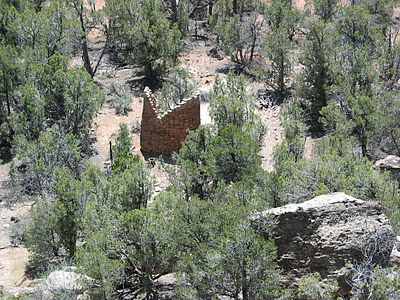Visit with Respect: A new film appeals to visitors to treat Ancestral Puebloan sites with care
Published in Indian Country Today in 2008. For more on topics like this, see my book, American Apartheid: The Native American Struggle....
 Visit with Respect, an affecting nine-minute film, attempts to protect fragile ancestral sites found throughout the Four Corners region by giving Native people a voice in describing them. The film’s producers are Victoria Atkins of Anasazi Heritage Center, a Bureau of Land Management site that is the gateway to Canyons of the Ancients National Monument, and Margie Connolly and Shirley Powell of Crow Canyon Archaeological Center, an educational and research organization with a campus in Cortez, Colorado.
Visit with Respect, an affecting nine-minute film, attempts to protect fragile ancestral sites found throughout the Four Corners region by giving Native people a voice in describing them. The film’s producers are Victoria Atkins of Anasazi Heritage Center, a Bureau of Land Management site that is the gateway to Canyons of the Ancients National Monument, and Margie Connolly and Shirley Powell of Crow Canyon Archaeological Center, an educational and research organization with a campus in Cortez, Colorado.
The film, which has just been completed, is shown to every visitor to the Anasazi Heritage Center and will be distributed free to schools and parks around the Southwest, said Atkins. (For a copy, contact the center at 970-882-5600.) The Society of Visual Anthropology and the American Anthropological Association have accepted Visit with Respect for a film festival the two organizations will host in San Francisco this coming November.
Numbers of tourists to the Southwest are continually growing, according to Roland Alonzi, of Colorado’s state tourism office. Because of the recent drop in the dollar’s value, that has included increases in foreign tourism, said Atkins. By adding subtitles in Spanish, French, German, Italian and Japanese, she and her co-producers have been able to bring their film’s message to the international audience passing through the area. Subtitles in English reach hearing-impaired visitors.
“Vandalism, unintentional damage by hikers, bikers and horseback riders, and simply the cumulative effect of all these visitors are increasing all over the West,” said Atkins. “Taking just one pottery sherd does damage. I can stand there in my BLM uniform and tell people not to climb on walls or take anything, but the people in this film bring the message home.”
Appearing in the film are well-known Pueblo leaders, scholars and artists Ernest M. Vallo, Sr., Acoma (shown above and below); Dawa Taylor, Hopi; and Dr. Tessie Naranjo and Rose B. Simpson, both of Santa Clara Pueblo. All stress the living connection between the ancestral places and the modern-day descendants of their builders. “This is our home,” says Simpson, sitting in a 13th-century village, “this is our mother.”
Twenty-five tribes and Pueblos trace their ancestry to the Four Corners region, says Naranjo in her narration. The film underscores that fact by presenting several generations of contemporary Native people interacting with the ancient sites.
In one segment, Taylor points out a mano, or corn-grinding stone, lying on the ground to his young son, Christian, and tells the boy that if he leaves it here, someday he’ll be able to bring his own children to see it. In any case, the father adds, looking over his shoulder at the remains of a nearby ancestral dwelling, “it belongs to the people who lived here.”
Naranjo notes that many ask where the long-ago inhabitants of the area went. “For us Pueblo people, we are them,” she says, “That is as certain as I’m sitting here. We are them. We have not gone away.”
The landscapes in the film, which was photographed and edited by Chris Simon, generally appear still and silent. This is just as one might expect when recording remote backcountry places no longer inhabited by living people. One startling exception is a shot of yellow blossoms waving in a little breeze among several ranks of old walls, making it suddenly easy to imagine the original liveliness of the place. Vallo explains at one point that today’s Pueblo people recognize that the ancestral sites are, indeed, alive with spirit.
So how does one approach these animated places? Vallo counsels just plain good manners — exactly what your parents or grandparents might have suggested: Ask the spirits for permission to enter them, then say thank you afterward.
Naranjo advises, “Visit with joy, visit with an open heart but, above all, visit with respect.”
Text and photos c. Stephanie Woodard.
Text and photos c. Stephanie Woodard.

